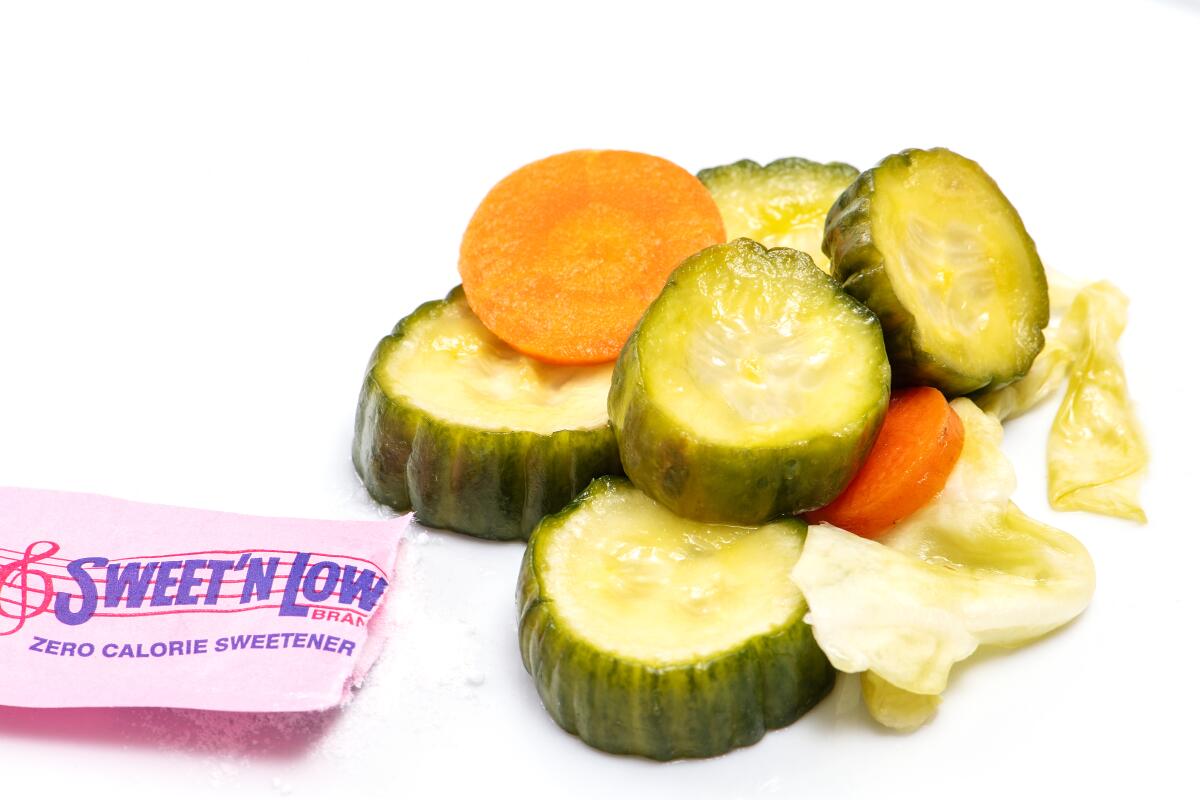The key to my grandma’s pickles? A pinch of Sweet’N Low

- Share via
My 85-year-old grandma Tina is always right. Whatever she says goes. And if you can’t find the logic in whatever she’s touting, you’d better try harder.
For years, she’s been making pickles with packets of Sweet’N Low she snags off restaurant tables.
“It seems like it brings the flavor,” she says.
She pickles sliced cucumbers, carrots and cabbage in a mixture of cold rice vinegar, salt and sweetener.
“Taste it first,” she says of her “recipe.” “If you put less salt and it tastes terrible, you have to add more salt.”
After a quick soak overnight, the vegetables retain their crunch. They are more sweet than salty, with a slight metallic tang. A passing whiff smells like ripe, festering garbage (delicious stuff is often stinky), and when you bite into the vegetables, your mouth floods with a rush of sweet pickle juice. (I like to eat them as an afternoon snack or, sometimes, as dessert. )
The pickles are similar to ones you’ll find at some Chinese restaurants: sliced cucumbers, carrots, cabbage and radishes pickled with ginger and garlic, often served as an appetizer or something to eat alongside char siu or boiled chicken. Some people refer to them as Cantonese pickles. Others just call them Asian pickles. My grandmother, who was born in Canton, China (now called Guangzhou), says she doesn’t know where they’re from, only that they are not American. She simply calls them “my pickles.”
She delivers them in repurposed, disposable plastic containers from restaurants or the market deli counter. (Often the lids don’t fit, or there’s a sticker that reads “coleslaw” stuck to the bottom.) My uncle once gave her 150 Styrofoam takeout boxes for Christmas. She’d never been happier.
For years we didn’t know how she made her pickles, until one afternoon, I asked, and she finally acknowledged her secret ingredient — a pinch of Sweet’N Low.
“A man taught me how they did it in his restaurant,” my grandmother said. She couldn’t tell me which one, just that it was in Alhambra, and that it had closed many years ago. I often find the plates of pickles listed in the appetizer section on restaurant menus in the San Gabriel Valley have that same slightly metallic flavor and wonder if someone in the kitchen is also using saccharin or aspartame, both of which taste significantly sweeter than the real stuff.
Once, while I was on a health kick in high school ( I’d read an article on the perils of saccharin in a medical journal), I tried to convince her to switch to sugar. She nodded her head without making eye contact. She tells me she just uses sugar now, but once in while I still find pink packets of Sweet’N Low on her kitchen counter.
More to Read
Eat your way across L.A.
Get our weekly Tasting Notes newsletter for reviews, news and more.
You may occasionally receive promotional content from the Los Angeles Times.











